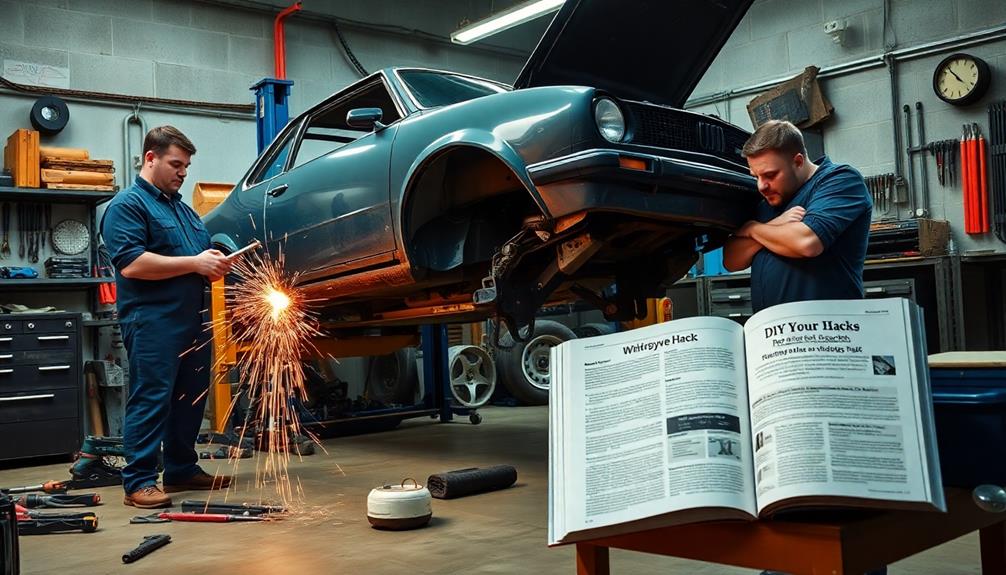Your windshield isn’t just for protection from wind and debris; it also acts as a essential structural member. It supports your vehicle’s framework, helps maintain roof integrity during crashes, and distributes crash energy to protect occupants. Made from laminated glass, it meets strict safety standards and works with other safety systems like airbags and seat belts. Understanding how it reinforces your car’s structure can help you appreciate its important role—continue exploring to learn more about its safety functions.
Key Takeaways
- Windshields act as load-bearing components, supporting the vehicle’s structural integrity during impacts and rollovers.
- Made from laminated glass and PVB, they are engineered to absorb crash energy and resist shattering.
- Safety standards require windshields to reinforce roof strength and maintain vehicle shape during collisions.
- Properly installed windshields work with airbags and the frame to enhance overall crashworthiness.
- They contribute to occupant protection by preventing roof collapse and supporting vehicle load distribution.

Introducing the windshield as a structural member shifts your perspective on its role beyond just glass protection. It’s easy to see a windshield as simply a barrier against wind, debris, and weather, but its function extends far beyond that. Modern windshields are engineered to contribute to your vehicle’s overall safety and integrity, acting as an essential component of the car’s structural framework. When considering this role, you realize that the material strength of the windshield is fundamental. Manufacturers select specialized materials that meet rigorous safety standards, guaranteeing the windshield can withstand impacts, resist shattering, and maintain its shape during accidents. These materials, often laminated glass combined with polyvinyl butyral (PVB), are designed to absorb and distribute crash energy, preventing dangerous shards from causing injuries. Additionally, the material strength of the windshield ensures it can support the vehicle’s load in various impact scenarios.
Windshields are engineered with specialized materials to withstand impacts and enhance vehicle safety.
The safety standards governing windshields are strict and meticulously enforced. They dictate not only the materials used but also how the windshield is constructed and installed. These standards guarantee that, in a collision, the windshield can support the roof’s integrity, reducing the risk of roof collapse and protecting passengers. They also specify the minimum strength the windshield must have to withstand forces such as wind pressure, vibrations, and impacts from debris. When your vehicle’s windshield complies with these safety standards, it contributes to the overall crashworthiness of your car, helping to protect you and your passengers in severe accidents.
By understanding the importance of material strength and safety standards, you start to appreciate how windshields are engineered for more than visibility. They’re integral to the vehicle’s safety system, working in tandem with airbags, seat belts, and the vehicle’s frame to ensure occupant protection. The adhesive used to secure the windshield also plays a critical role, providing additional strength and stability. Proper installation ensures that the windshield remains in place during crashes, further supporting the vehicle’s structural integrity.
In essence, the windshield acts as a load-bearing element, sharing the structural load during impacts and helping to maintain the vehicle’s shape. This role is especially essential in rollovers, where the windshield can help prevent the roof from collapsing. So, next time you look at your vehicle’s windshield, remember it’s not just glass—it’s a carefully engineered component that adheres to strict safety standards and material strength requirements. Its design and construction are deliberate choices aimed at protecting you, reinforcing the vehicle’s structure, and ensuring safety in a variety of driving situations.
Frequently Asked Questions
How Does a Windshield Contribute to Vehicle Safety?
Your windshield enhances vehicle safety by supporting airbag deployment, ensuring the airbags deploy correctly during a crash. It also uses glass bonding to hold itself securely in place, preventing shattering and reducing injury risk. By maintaining structural integrity, the windshield helps protect you from ejection and provides a stable surface for safety features. This makes it an essential component in safeguarding you during accidents.
What Materials Are Used in Structural Windshields?
You’ll find that structural windshields typically use tempered glass, which is treated to break into small, blunt pieces for safety. Sometimes, polycarbonate material is incorporated for added impact resistance and flexibility. These materials guarantee your windshield withstands forces during collisions, provides clear visibility, and maintains integrity. Manufacturers choose tempered glass for its strength and safety, while polycarbonate offers lightweight durability, making your vehicle safer and more reliable during accidents or environmental stresses.
Can a Windshield Be Replaced Without Affecting Structural Integrity?
You can replace a windshield without compromising structural integrity if you guarantee proper procedures. Studies show that adhesive bonding improves safety by maintaining the vehicle’s strength during impacts. During replacement, frame reinforcement is vital to support the new windshield. Use high-quality adhesive bonding techniques, and professional installation is essential to preserve your vehicle’s safety features and structural integrity. Always trust certified technicians for this essential task.
How Do Windshields Perform in Crash Tests?
You’ll find that windshields perform well in crash tests due to adhesive bonding and their glass composition. Modern adhesives secure the windshield firmly, helping absorb impact energy, while specialized glass, typically laminated safety glass, prevents shattering into dangerous shards. These materials work together to maintain passenger safety during collisions, ensuring the windshield contributes to overall vehicle integrity without compromising visibility or protection.
Are There Regulations Governing Windshields as Structural Members?
Yes, regulations govern windshield design and manufacturing standards to guarantee safety and durability. You must follow strict guidelines that specify how windshields should be constructed, tested, and installed. These standards cover materials, bonding techniques, and impact resistance. By adhering to these rules, you help ensure that windshields can withstand crashes, provide structural support, and protect occupants—making your vehicle safer and compliant with legal requirements.
Conclusion
Although the windshield may seem like just a glass panel, it plays a crucial structural role in your vehicle’s safety. It’s a fragile barrier that’s simultaneously strong enough to support impacts and contribute to the car’s rigidity. Just as a delicate window can hold back a storm, your windshield balances vulnerability with resilience. Recognize its dual nature—fragile yet essential—because in both safety and design, sometimes strength hides behind transparency.









